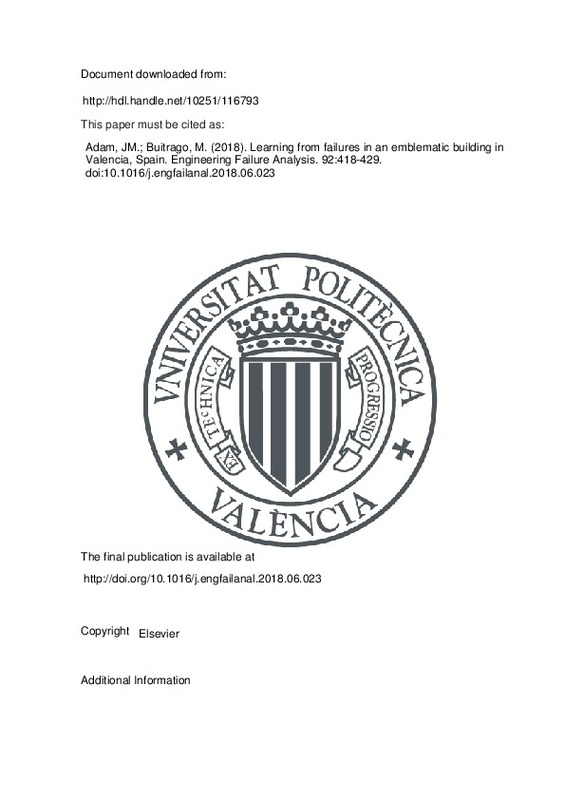JavaScript is disabled for your browser. Some features of this site may not work without it.
Buscar en RiuNet
Listar
Mi cuenta
Estadísticas
Ayuda RiuNet
Admin. UPV
Learning from failures in an emblematic building in Valencia, Spain
Mostrar el registro sencillo del ítem
Ficheros en el ítem
| dc.contributor.author | Adam, Jose M
|
es_ES |
| dc.contributor.author | Buitrago, Manuel
|
es_ES |
| dc.date.accessioned | 2019-02-17T21:03:35Z | |
| dc.date.available | 2019-02-17T21:03:35Z | |
| dc.date.issued | 2018 | es_ES |
| dc.identifier.issn | 1350-6307 | es_ES |
| dc.identifier.uri | http://hdl.handle.net/10251/116793 | |
| dc.description.abstract | [EN] On many occasions advances have been made in science and engineering thanks to the knowledge gained from failures. In the particular case of structural engineering, the study of actual failures makes it possible to advance and define new theories, concepts and designs. Some examples are the changes and improvements that appeared after some of the "classical" failures such as the Ronan Point building, Quebec Bridge, Murrah Federal Building, Tacoma Narrows Bridge and the World Trade Center. This paper describes a teaching method used with structural engineering students at the Universitat Politecnica de Valencia based on the study of cases of damage to buildings in Valencia, Spain. Due to its special characteristics, one of the buildings studied is the Principe Felipe Science Museum. Some of its main characteristics are: 1) it is one of Valencia's emblematic buildings, 2) its considerable dimensions required huge quantities of concrete, 3) it has a complex structure and an innovative architectural design, 4) the wide variation in the type of damage detected, which make it a particularly valuable teaching aid. The most important damage detected has been classified and described during the visits to the Principe Felipe Science Museum. The damage mechanisms are widely diverse and include: those due to the behaviour of the concrete itself (e.g. shrinkage and early age thermal cracking), those due to the presence of damp, those whose origin can be traced back to the construction phase, and others due to corroded reinforcement and to the loads acting on the structure. The paper has a double value since on one hand it describes a highly successful teaching aid for the training of experts in structural engineering, while on the other it classifies and describes the existing damage in one of the most important modern buildings in Spain and perhaps in Europe. | es_ES |
| dc.language | Inglés | es_ES |
| dc.publisher | Elsevier | es_ES |
| dc.relation.ispartof | Engineering Failure Analysis | es_ES |
| dc.rights | Reconocimiento - No comercial - Sin obra derivada (by-nc-nd) | es_ES |
| dc.subject | Damage | es_ES |
| dc.subject | Failure | es_ES |
| dc.subject | Building | es_ES |
| dc.subject | Teaching | es_ES |
| dc.subject | Learning | es_ES |
| dc.subject.classification | INGENIERIA DE LA CONSTRUCCION | es_ES |
| dc.title | Learning from failures in an emblematic building in Valencia, Spain | es_ES |
| dc.type | Artículo | es_ES |
| dc.identifier.doi | 10.1016/j.engfailanal.2018.06.023 | es_ES |
| dc.rights.accessRights | Abierto | es_ES |
| dc.contributor.affiliation | Universitat Politècnica de València. Departamento de Ingeniería de la Construcción y de Proyectos de Ingeniería Civil - Departament d'Enginyeria de la Construcció i de Projectes d'Enginyeria Civil | es_ES |
| dc.description.bibliographicCitation | Adam, JM.; Buitrago, M. (2018). Learning from failures in an emblematic building in Valencia, Spain. Engineering Failure Analysis. 92:418-429. doi:10.1016/j.engfailanal.2018.06.023 | es_ES |
| dc.description.accrualMethod | S | es_ES |
| dc.relation.publisherversion | http://doi.org/10.1016/j.engfailanal.2018.06.023 | es_ES |
| dc.description.upvformatpinicio | 418 | es_ES |
| dc.description.upvformatpfin | 429 | es_ES |
| dc.type.version | info:eu-repo/semantics/publishedVersion | es_ES |
| dc.description.volume | 92 | es_ES |
| dc.relation.pasarela | S\364990 | es_ES |







![[Cerrado]](/themes/UPV/images/candado.png)

